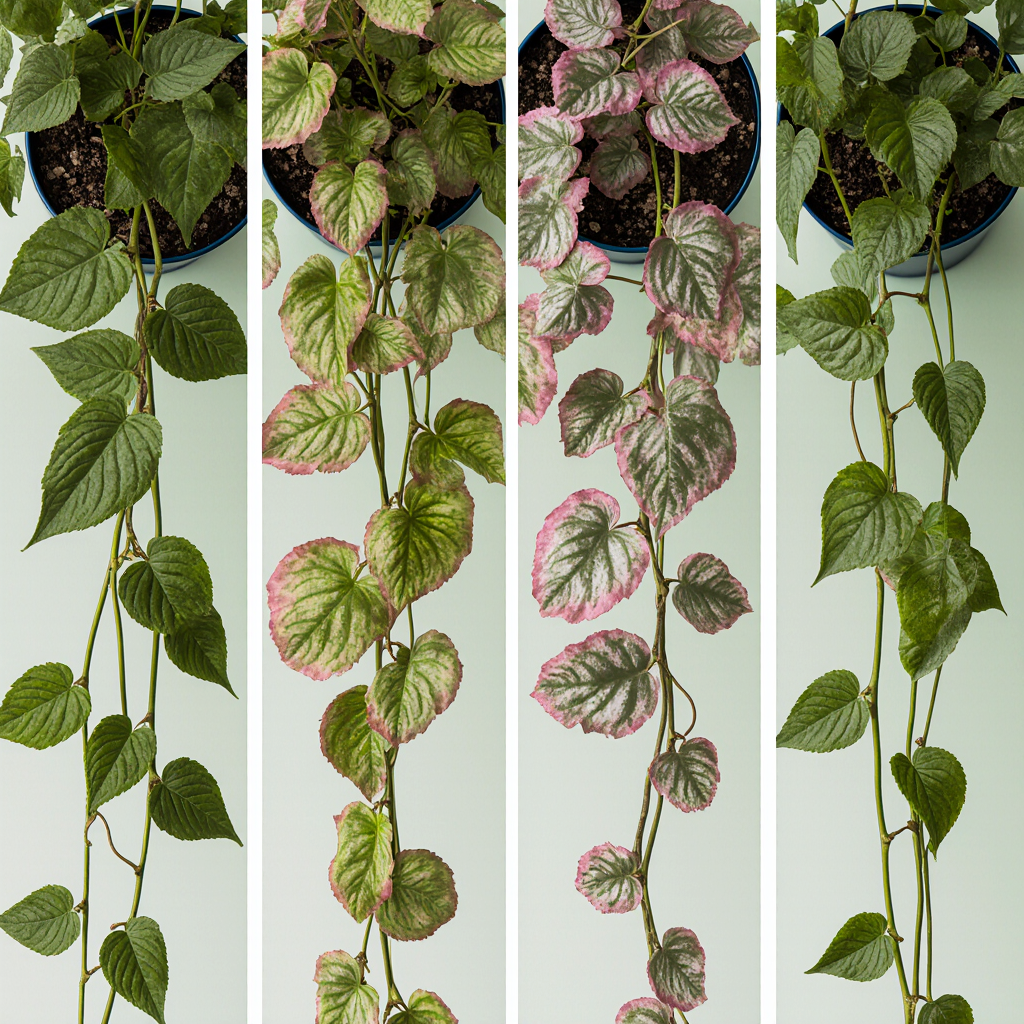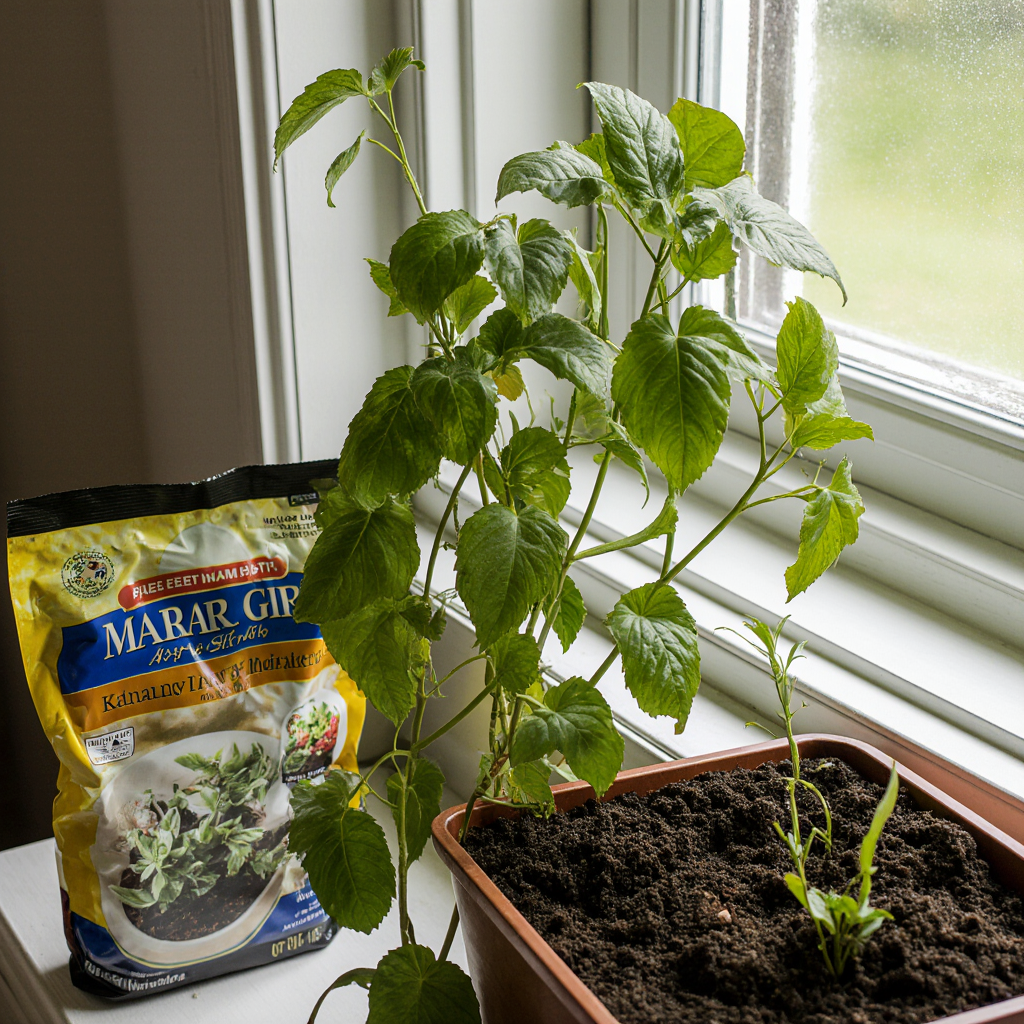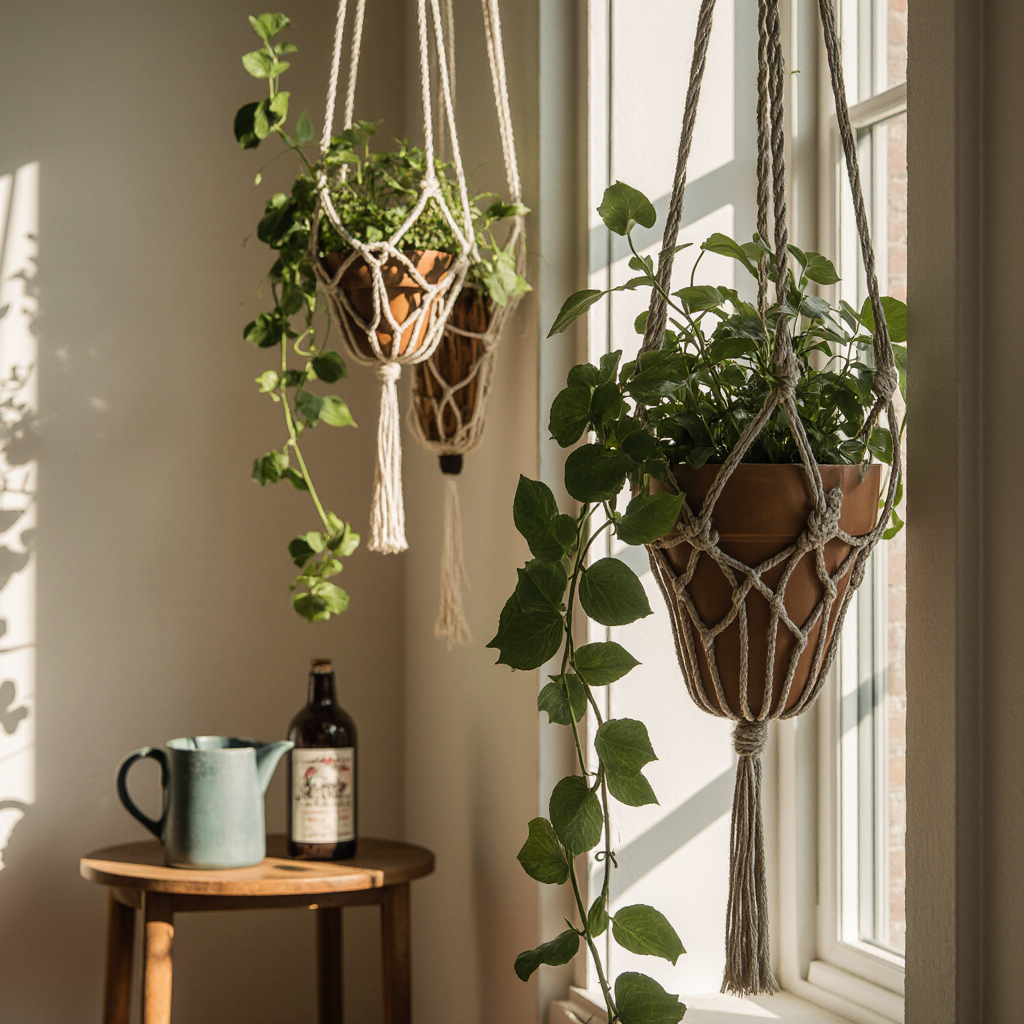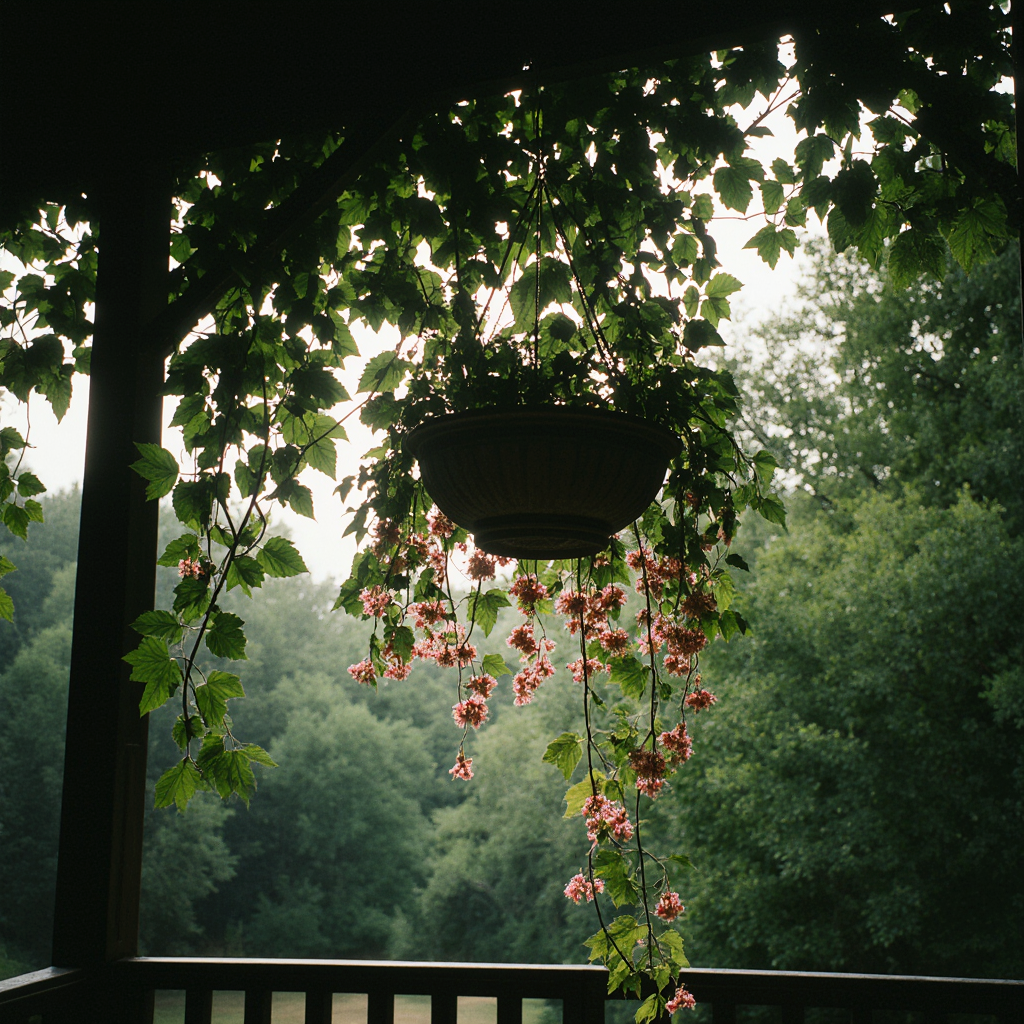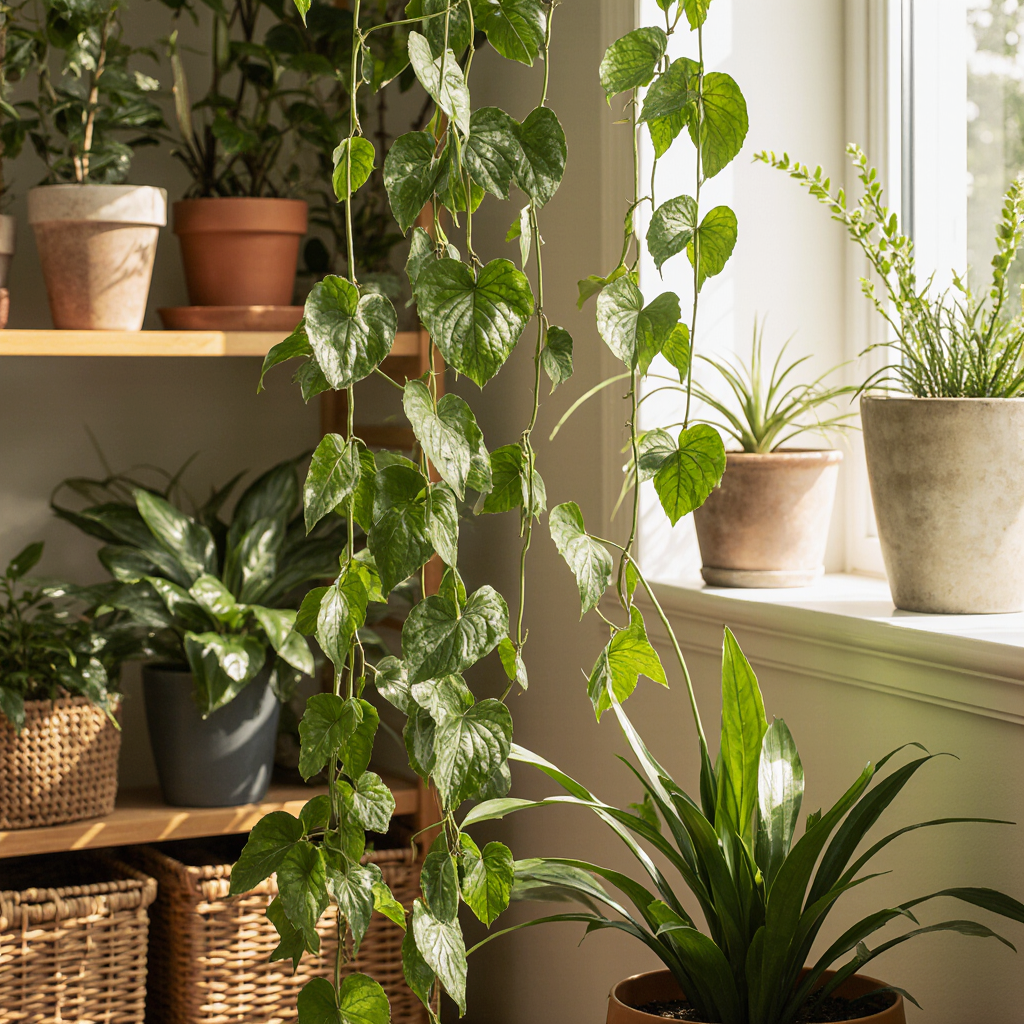
Looking for a houseplant that’s equal parts charming and low-maintenance? Meet the Rosary Vine—aka String of Hearts—your new favorite trailing beauty! With its delicate heart-shaped leaves, whimsical vines, and irresistible personality, this little stunner adds instant magic to any windowsill, shelf, or hanging basket.
But don’t let its dainty look fool you. The Rosary Vine is tougher than it looks—and with the right care, it’ll thrive and trail like a botanical goddess.
In this guide, we’ll show you everything you need to know to grow a lush, thriving Rosary Vine that’ll make your plant-loving friends do a double take. From sunlight secrets to propagation hacks, we’ve packed this care guide with all the dirt (literally) you need. Keep reading—your heart-shaped jungle awaits! 💚🌿.
🌿 Introduction to Rosary Vine (Ceropegia woodii)
If you’ve ever imagined the perfect blend of elegance, quirk, and botanical charm all wrapped into one houseplant — meet the Rosary Vine. This dainty beauty, with its cascading strands and perfectly shaped heart leaves, isn’t just another pretty face on your plant shelf. It’s a conversation starter, a fast grower, and a plant that thrives on a little bit of love and a lot of indirect light.
Whether you’re a beginner in the plant world or a trailing vine enthusiast, Ceropegia woodii will quickly steal your heart. But don’t let its delicate appearance fool you — this houseplant is tougher and more adaptable than it looks.
Let’s dive into what makes the Rosary Vine so special, from its roots in southern Africa to the way it gracefully tumbles from shelves, hangers, or even desktop pots.
💡 What Is a Rosary Vine?
The Rosary Vine, known by its botanical name Ceropegia woodii, is a semi-succulent trailing vine native to the dry woodlands and rocky slopes of South Africa, Eswatini (Swaziland), and Zimbabwe. Despite its fragile appearance, this plant has evolved to thrive in challenging conditions, making it surprisingly easy to care for indoors.
Botanically speaking, it belongs to the Apocynaceae family — the same plant family as hoyas and oleanders. As a trailing plant, it sends out thin, wiry stems that can stretch for several feet. Along these vines, you’ll find pairs of tiny, plump leaves shaped like hearts — hence the name “String of Hearts.” But the magic doesn’t stop there. Little bead-like tubers also form along the stems, giving it the name “Rosary Vine” — like a botanical necklace that just keeps growing.
Despite its exotic origins, this plant adapts beautifully to indoor life and has become a popular staple in homes across the globe. Its whimsical nature, low-maintenance needs, and fast-growing tendencies have made it a darling among plant lovers of all levels.
🏷️ Common Names and Botanical Background
While Ceropegia woodii is the official Latin name, this plant goes by several fun and poetic nicknames — many of which highlight its beautiful leaves and cascading form. You might hear it called:
- String of Hearts – The most popular name, inspired by its perfectly symmetrical, heart-shaped leaves that appear along long trailing vines.
- Chain of Hearts – A fitting term for the way the leaves line up along the stem, looking like a chain of green and silver hearts.
- Sweetheart Vine – A name that captures its romantic aesthetic and delicate nature.
- Rosary Plant – This name references the small, round tubers that form along the vines, which resemble rosary beads and help with water storage and propagation.
- Ceropegia woodii – The formal name used in nurseries, botanical gardens, and among plant collectors.
No matter what you call it, one thing’s for sure — it has no shortage of fans!
💖 Unique Features of the Rosary Vine
So what makes the Rosary Vine stand out in a sea of houseplants? Let’s explore its most charming qualities:
- Heart-shaped leaves: Each pair of leaves grows in opposite directions along the stem, forming a charming trail of hearts. Some are solid green, while others feature beautiful silver variegation or purple undersides that change with lighting conditions.
- Cascading vines: This plant doesn’t just grow — it drapes. Its thin, wiry stems can grow several feet long, making it ideal for hanging planters or shelves where it can show off its graceful fall.
- Rosary-like tubers: One of the plant’s more fascinating features is the presence of small, bead-like tubers that appear along the stems. These not only store moisture but can also grow into new plants, giving you propagation opportunities with zero fuss.
- Purple blushing: In strong light, the leaf undersides often develop a soft purple hue, adding even more dimension to the plant’s aesthetic.
- Resilient nature: Despite its delicate looks, this plant is a low-maintenance dream. It tolerates some neglect, loves bright indirect light, and can go a bit between waterings without drama.
- Decorative versatility: From minimalist modern spaces to cozy boho corners, the Rosary Vine adds a touch of greenery without demanding center stage. Whether you drape it over a bookshelf or let it cascade from a hanging planter, it delivers instant charm.
The Rosary Vine is not just another houseplant — it’s a gentle cascade of green love notes that turns any room into a tranquil, whimsical haven. Whether you’re just starting your houseplant journey or looking to add a little romance to your collection, this plant is a must-have.
Ready to give your String of Hearts the TLC it deserves? Let’s move on to how to grow and care for it like a pro. 🌱💚
🌸 Types and Varieties of Rosary Vine
If you thought the classic String of Hearts was gorgeous, wait until you meet her extended family. The Rosary Vine isn’t a one-look wonder — oh no. It comes in a small but mighty collection of cultivars that each bring their own flair, from silvery sparkle to dramatic dark foliage.
Whether you’re all about aesthetic vibes, low-maintenance plants, or just need an excuse to collect all the varieties (we see you), there’s a version of Ceropegia woodii with your name on it.
🌟 Most Popular Cultivars (a.k.a. The Rosary Vine Dream Team)
Let’s break down the A-listers of the Rosary Vine world:
- Ceropegia woodii (Standard/Classic String of Hearts)
This is the OG. The leaves are dark green with silver marbling on top and a soft purplish hue underneath. Graceful, elegant, and fast-growing — it’s the go-to for trailing vibes. - Ceropegia woodii variegata (Variegated String of Hearts)
A fan favorite for a reason. This beauty has soft green leaves edged in creamy white or blush pink. When exposed to bright, indirect light, it shows off those pastel pink tones even more. Instagrammable? You bet. - Ceropegia woodii ‘Silver Glory’
Think drama with a touch of glam. The leaves are rounder than the classic heart shape and covered in a striking, almost metallic silver sheen with dark green edging. It’s like the couture version of the original. - Ceropegia woodii ‘String of Spades’
This version has slightly pointier leaves that resemble — you guessed it — tiny spades. Dark green, edgy, and just a little mysterious, it’s perfect if you want something slightly different without straying too far from the classic.
🍃 Differences in Leaf Shape, Size, and Coloration
Even though they’re all from the same plant family, each variety brings something unique to the (plant) table:
| Variety | Leaf Shape | Color Pattern | Underside Hue |
| Classic | Heart-shaped | Green with silver | Purple |
| Variegated | Heart-shaped | Green, cream, pink | Light pink |
| Silver Glory | Round/heart mix | Solid silver + dark edge | Purplish gray |
| String of Spades | Spade-shaped | Dark green, subtle silver | Deep purple |
These slight variations in leaf shape and color might seem subtle, but when they’re all growing together on one shelf? Pure plant magic.
🌱 Which Variety is Best for You?
Choosing the right Rosary Vine variety depends on your personality, aesthetic, and how much sunlight your space gets. Here’s a little guide to help you pick your plant soulmate:
- For total beginners:
Go with the classic String of Hearts. It’s the most forgiving, fastest-growing, and a perfect starter if you’re still figuring out your watering schedule. - For pink lovers or pastel decor fans:
The variegated version is your new best friend. Just make sure it gets enough light to bring out those blush tones! - For bold statement makers:
Say hello to Silver Glory. Its silvery sheen makes it a standout in any collection and adds a cool-toned contrast to your leafy lineup. - For the plant collector who wants something different:
Go for String of Spades. It’s just unusual enough to get people asking “what is that?” without sacrificing the ease of care.
With their trailing stems and stunning leaves, every type of Rosary Vine brings something special to the table. And honestly? You don’t have to choose just one — these varieties grow beautifully side-by-side, creating a full-blown String of Hearts Symphony.
Ready to make them thrive? Let’s talk about the best growing conditions next! 🌞🌱
🌞 Ideal Growing Conditions for Rosary Vine
To grow a happy and thriving rosary vine, you don’t need a greenhouse or magical plant powers — just the right balance of light, warmth, and a well-draining home for its roots.
The ceropegia rosary vine is fairly adaptable, but if you really want those vines to trail long and the hearts to pop with color, here’s what you need to know.
💡 Light Requirements
The rosary vine string of hearts absolutely adores bright, indirect light. Think near a south-facing window with sheer curtains or a spot that gets filtered sunshine for most of the day.
- Ideal: Bright, indirect light (around 4–6 hours a day)
- Tolerated: Morning sun or dappled light
- Avoid: Harsh midday rays (can scorch those delicate leaves) and deep shade (leads to leggy vines and muted color)
If your ceropegia rosary vine starts stretching and fading, it’s politely begging for more sunshine.
🌡️ Temperature & Humidity Preferences
As a native of Southern Africa, the rosary vine prefers things on the warm and cozy side.
- Best temperature range: 18°C to 27°C (65°F to 80°F)
- Minimum tolerated: 10°C (50°F)
- Humidity: This trailing cutie thrives in average household humidity — no tropical rainforest needed!
That makes the rosary vine string of hearts perfect for life on your windowsill, no matter the season.
🌱 Soil Type & Potting Mix
The ceropegia rosary vine is semi-succulent, which means soggy soil is its mortal enemy. It wants to soak up water quickly — and then dry out just as fast.
Ideal soil mix:
- 2 parts cactus or succulent soil
- 1 part perlite or coarse sand
- Optional: a handful of orchid bark for better airflow
This combo keeps roots healthy and helps prevent dreaded root rot — a common issue for over-loved (overwatered) plants.
🪴 Best Containers & Hanging Setups
Let those vines fly! The rosary vine string of hearts loves to dangle, so pick containers that show off its natural cascade.
Top container ideas:
- Hanging baskets with drainage holes
- Macramé plant hangers (for boho vibes)
- Wall-mounted planters for vertical drama
- Shallow ceramic pots that allow stems to spill over the edge
Whatever you choose, make sure it has drainage holes. A waterlogged rosary vine is a sad vine.
With the right light, breathable soil, and a comfy home to hang from, your ceropegia rosary vine will reward you with vines that grow longer, leaves that get richer in color, and maybe even the occasional surprise bloom. Think of it as creating a personal paradise — one tiny heart at a time.
🌱 How to Grow and Propagate Rosary Vine Successfully
Growing and propagating your rosary vine is like creating your own little green paradise — and the best part? It’s easier than you might think! Whether you’re starting from a cutting or a tuber, these little heart-shaped leaves will quickly become your favorite indoor accessory. Let’s walk through the simple steps to growing a ceropegia rosary vine and multiplying it like a true plant parent.
✂️ Step-by-Step Guide for Planting from Cuttings or Tubers
Starting a new rosary vine string of hearts from a cutting or tuber is a fun, rewarding process. Here’s how you do it:
-
- Take a cutting:
- Snip a healthy stem with at least two to three nodes (the little bumps where leaves grow).
- Make sure to use clean, sharp scissors to avoid damaging the plant.
- Trim just below a node to maximize the cutting’s potential for rooting.
- Let it callus:
- Lay the cutting in a dry place for 1–2 days to allow the cut end to callus over. This helps prevent rot when it’s planted.
- Plant the cutting:
- After it’s callused, place the cutting in well-draining soil (a mix of cactus soil and perlite works wonders).
- Alternatively, you can plant it directly in water, allowing the roots to develop before transferring it to soil.
- Take a cutting:
- Planting from tubers:
-
- If you’re working with a tuber (those little “beads” along the vine), simply plant it in the soil with the flat side facing down, about an inch below the surface.
- Water sparingly until you see new growth.
💧 Watering Frequency and Techniques
The rosary vine is a bit of a water minimalist — it prefers to dry out between waterings. Over-watering is one of the easiest ways to stress out your ceropegia rosary vine.
- Watering frequency: Only water when the top 2–3 inches of soil are dry. Depending on the temperature and season, this might be once every 1–2 weeks.
- Watering technique: Water thoroughly until it runs out the bottom of the pot, but don’t let your rosary vine string of hearts sit in water.
- Signs it needs water: The leaves will start curling in, or the plant might begin looking a little limp. But, always check the soil first — don’t rush to water!
Pro tip: When the weather cools down, you can cut back on watering. Your rosary vine will go into a semi-dormant state and won’t need as much attention.
🌿 How to Encourage Fuller Growth and Trailing Vines
If you’re aiming for a bushier, fuller rosary vine string of hearts with those classic cascading vines, here are a few tips to help your plant thrive:
- Pinch back the tips: Snip off the growing tips to encourage branching and create a fuller, bushier appearance. This works especially well for the younger plants.
- Provide support: If your ceropegia rosary vine starts to grow long and leggy, try adding a small trellis or letting the vine spill over the edge of a shelf.
- Consistent light: Ensure your plant gets enough bright, indirect light. Without it, the vines might grow weak and sparse.
- Fertilize lightly: Feed your plant once a month during the growing season with a balanced, diluted fertilizer. Too much fertilizer can damage the roots, so keep it light!
🌱 Tips for Propagation in Water vs. Soil
Both methods of propagation (water or soil) can lead to success, but each has its own charm. Here’s how to decide:
- Water propagation:
- Place the cutting in a jar of water, ensuring that at least one node is submerged.
- Change the water every few days to keep it fresh and encourage fast root growth.
- Once the roots are a few inches long, you can transfer the cutting to soil.
- Soil propagation:
- For a faster, more direct route to root growth, stick your cutting directly into well-draining soil.
- Keep the soil lightly moist but not soggy, and keep the cutting in a warm area with indirect sunlight until it establishes roots.
Water propagation is more fun to watch, but soil propagation tends to be a bit faster for rosary vine lovers who are impatient for results. Either way, you’ll end up with a beautiful new ceropegia rosary vine in no time!
With these easy steps, you’ll be well on your way to growing a lush, thriving rosary vine string of hearts and multiplying your plant family. Ready for more? Stay tuned as we dive into common troubleshooting tips and how to keep your ceropegia rosary vine in tip-top shape.
🪴 Rosary Vine Indoor Care Tips
So you’ve brought home a gorgeous rosary vine string of hearts, and now you’re wondering: “Where should I put it? How often should I feed it? What do I do when winter rolls around?” Don’t worry — this part is where the magic happens. Indoor care is where the ceropegia rosary vine truly shines, as long as you give it the cozy conditions it craves.
Let’s go over everything you need to know to keep your rosary vine not just alive, but thriving — heart-leafed vines and all.
🪟 Placement Tips: Where Your Rosary Vine Will Feel at Home
One of the best parts about the rosary vine string of hearts is how versatile it is in your space. Whether you live in a tiny apartment or a sun-filled villa, this plant knows how to work a room.
Ideal spots for indoor placement:
- Bright windowsills: A south or east-facing window is the sweet spot. Just be sure to use a sheer curtain to filter harsh sunlight.
- Hanging baskets near light: Let the vines drape down for that signature cascading look.
- Shelves or high ledges: Let your ceropegia rosary vine trail down bookshelves or wall-mounted planters for a dramatic green curtain.
- Avoid deep shade or north-facing rooms: The leaves will lose color and vines may get sparse.
The more bright, indirect light your plant gets, the more full, colorful, and happy it will be.
🌿 Fertilizing Schedule and Nutrients Needed
Even low-maintenance houseplants need a little snack every now and then — and your rosary vine is no different.
Fertilizing tips for optimal growth:
- Frequency: Once a month during spring and summer (active growing season).
- Type: Use a balanced, water-soluble houseplant fertilizer — something like a 10-10-10 mix works well.
- Dilution: Always dilute to half strength; this plant is sensitive to overfeeding.
- Skip in winter: When your ceropegia rosary vine goes dormant, it doesn’t need any food. Let it rest and recharge.
If you’re seeing long, stretchy vines with fewer leaves, a gentle fertilizer boost could be the encouragement it needs.
💧 Common Signs of Overwatering or Root Rot
The rosary vine string of hearts is not a fan of soggy feet. Overwatering is one of the most common mistakes, but luckily, the plant gives you warning signs before things get out of hand.
Watch out for:
- Yellow, mushy leaves: Early sign of overwatering.
- Blackened stems or roots: A classic symptom of root rot.
- A funky smell from the soil: Not good! Time to repot with fresh, dry soil.
- Leaves dropping suddenly: The roots might be drowning — check moisture levels.
Best way to avoid it? Always let the soil dry out between waterings, and make sure your pot has excellent drainage. The ceropegia rosary vine would rather be a little thirsty than drowning in love (and water).
❄️ Seasonal Care Changes: Winter Dormancy & Summer Boosts
Like all great houseplants, the rosary vine follows a seasonal rhythm. Here’s how to care for it year-round:
Winter (Dormancy Mode):
- Growth slows down — don’t panic!
- Water less often (every 3–4 weeks depending on indoor temps).
- No need for fertilizer.
- Avoid cold drafts and sudden temperature drops.
Spring & Summer (Growth Mode):
- Water when the top 2 inches of soil are dry.
- Fertilize monthly to fuel new growth.
- Consider repotting if it’s root-bound.
- Propagation season! Your rosary vine string of hearts will be eager to multiply.
Understanding the seasonal changes in your ceropegia rosary vine‘s behavior helps you work with the plant, not against it.
When cared for properly indoors, the rosary vine becomes a plant that just keeps on giving — more vines, more hearts, more beauty. Give it the right spot, the right food, and a little patience, and it’ll reward you with a cascade of botanical love all year round.
🌿 Outdoor Growing Tips for Rosary Vine
The rosary vine string of hearts may be known for stealing the spotlight indoors, but did you know it can also thrive outdoors — with the right conditions? This delicate-looking trailing vine is surprisingly adaptable when you give it a little sun, a cozy spot, and a bit of protection from Mother Nature’s mood swings.
Let’s explore everything you need to know to help your ceropegia rosary vine make a graceful leap from windowsill beauty to outdoor stunner.
🌎 Can Rosary Vine Grow Outdoors Year-Round?
Short answer: Yes, but only if you live in the right climate.
The rosary vine is native to warm, dry regions and doesn’t enjoy cold snaps or soggy soil. If you’re blessed with mild winters, it can happily live outside all year. Otherwise? Think of it as a seasonal outdoor guest that needs to come back inside when the weather gets chilly.
Key considerations:
- It thrives outdoors in spring and summer in most climates.
- In colder regions (with frost or snow), bring your plant indoors when temperatures dip below 10°C (50°F).
- Permanent outdoor placement is only ideal in warmer zones — more on that next.
🗺️ Ideal USDA Zones and Outdoor Placement
The ceropegia rosary vine grows best outdoors in USDA zones 10 to 12, where winters are mild and frost is rare.
If you’re in these zones, your rosary vine string of hearts can enjoy life on patios, balconies, or even hanging from trees!
Outdoor placement tips:
- Choose a shaded patio, covered porch, or spot with morning sun and afternoon shade.
- Hanging baskets and wall planters keep it safe from curious pets and heavy rainfall.
- Use pots with excellent drainage so the plant doesn’t sit in water after rainstorms.
Not in zone 10 or above? Don’t worry — you can still bring your rosary vine outside during the warm months and move it back in when autumn hits.
☀️🌬️ Protecting from Direct Sun, Wind, and Frost
Although the rosary vine loves light, it’s not a fan of harsh outdoor elements. Here’s how to keep it safe and flourishing outdoors:
- Sun: Bright, indirect light is key. A bit of early morning sun is okay, but avoid hot afternoon rays that can scorch the leaves.
- Wind: Gentle breezes are fine, but strong winds can snap those dainty vines. Choose a sheltered location or hang it somewhere protected.
- Rain: Occasional showers? Totally fine. Constant downpours? Not so much. Ensure the pot drains freely to prevent root rot.
- Frost: A big no-no for your ceropegia rosary vine. Bring it indoors as soon as nighttime temperatures drop near freezing.
Pro tip: If you’re not sure how much light your outdoor spot gets, watch the shadows during the day. Dappled light and filtered shade are ideal.
🔁 Transitioning Between Indoor and Outdoor Environments
If you’re planning to give your rosary vine string of hearts a summer vacation on the balcony, make the move gentle and gradual.
Here’s how to do it like a pro:
- Acclimate slowly: Start by placing your plant outdoors in a shaded spot for a few hours a day. Gradually increase exposure over a week.
- Check for pests: Before moving your plant back inside, inspect for aphids, mealybugs, or sneaky spider mites.
- Repot if needed: If your rosary vine has outgrown its container during the summer, give it a fresh pot before bringing it indoors.
- Reduce watering when moving inside: Less sunlight = slower growth = less water needed.
Transitioning your ceropegia rosary vine between indoor and outdoor life helps it stay healthy, lush, and stunning year-round — no shock, no droop, just happy trailing hearts.
With these outdoor growing tips, your rosary vine can enjoy fresh air, filtered sunshine, and warm summer breezes while still staying safe from the elements. Whether it’s hanging under a pergola or adorning your patio, this sweet trailing plant knows how to make any space look like a dreamy botanical escape.
🛠️ Troubleshooting Common Rosary Vine Problems
Even the most low-maintenance houseplants have their drama now and then — and the rosary vine is no exception. But don’t panic! Whether your rosary vine string of hearts is yellowing, stretching like it’s training for a yoga class, or just looking a little sad, we’ve got the quick fixes and pro tips to bring it back to life.
Let’s dive into the most common problems, what they mean, and how to get your ceropegia rosary vine thriving again in no time.
🍃 Yellowing Leaves, Stretching, and Stunted Growth
Noticing your vine’s leaves turning yellow, growing leggy, or just stalling? Your rosary vine is sending you some subtle (and not-so-subtle) messages.
What might be going wrong:
- Yellowing leaves
Often a sign of overwatering. Check the soil — if it feels soggy, let it dry out completely before watering again. - Leggy, stretched vines
This is classic light deprivation. Your rosary vine string of hearts needs more indirect sunlight. Move it closer to a bright window — just avoid direct midday rays. - Stunted growth or leaf drop
Could be due to a lack of nutrients, root-bound conditions, or seasonal dormancy. Evaluate your fertilizing routine and check if it’s time to repot.
Quick tip: Rotate your pot weekly for even light exposure and balanced growth.
🐛 Pest Issues (Aphids, Mealybugs, Spider Mites)
Unfortunately, even the adorable ceropegia rosary vine isn’t immune to uninvited guests. Pests like aphids, mealybugs, and spider mites love to snack on tender vines and leaves.
Spot the signs:
- Aphids: Tiny green or black bugs clustering on new growth.
- Mealybugs: White, cottony blobs at leaf joints or on the soil surface.
- Spider mites: Webbing under leaves or between vines, plus speckled leaf damage.
Treatment plan:
- Rinse the plant with lukewarm water to remove visible pests.
- Spray with a mix of water and mild dish soap (or neem oil) weekly until pests are gone.
- Isolate the infected plant to avoid spreading!
Consistency is key — check your rosary vine weekly for signs of pests, especially during spring and summer when they’re most active.
🚫 Root Rot Prevention and Recovery Methods
Root rot is a sneaky villain that often creeps in when we over-love (read: overwater) our plants. The rosary vine string of hearts is especially vulnerable due to its semi-succulent nature.
Prevention tips:
- Always use a well-draining potting mix.
- Choose a pot with drainage holes — no exceptions!
- Let the soil dry between waterings.
If you suspect root rot:
- Gently remove the plant from the pot and inspect the roots.
- Trim off any black, mushy, or foul-smelling roots.
- Repot in fresh, dry soil in a clean container.
- Hold off on watering for a few days to let the plant reset.
If caught early, your ceropegia rosary vine can bounce back beautifully.
🌱 Tips for Reviving a Struggling Rosary Vine
Don’t give up on your plant just yet! The rosary vine is surprisingly resilient, and with a little care, it can recover from most setbacks.
How to revive your plant:
- Prune dead or leggy vines to encourage bushier growth.
- Increase light gradually if it’s been living in dim conditions.
- Refresh the soil if it’s compacted, soggy, or depleted.
- Propagate healthy vines into new soil to create a fuller, happier plant.
And most importantly, be patient. Recovery doesn’t happen overnight — but within a few weeks, you’ll start to see new growth, stronger vines, and brighter leaves. Your rosary vine string of hearts just needs a little love (and maybe a sunnier seat).
With these troubleshooting tips in your plant care toolkit, you’re ready to handle anything your ceropegia rosary vine throws your way. From pest patrol to light balance and root rescue, you’re well on your way to mastering the art of the heart — one trailing vine at a time.
FAQ
How do you take care of a rosary vine?
To care for a rosary vine, provide bright, indirect light, water sparingly once the soil has dried out, and use a well-draining potting mix. This trailing plant prefers warm temperatures and moderate humidity, making it ideal for indoor environments. Regular pruning helps maintain a fuller look and encourages new growth on your rosary vine string of hearts.
Do strings of hearts like to climb or hang?
The rosary vine string of hearts is a naturally trailing plant that thrives when allowed to hang from shelves, baskets, or high planters. However, it can also be trained to climb with gentle support if desired. Whether hanging or climbing, the plant maintains its signature cascading vine aesthetic.
Is rosary vine a succulent?
Yes, the rosary vine is considered a semi-succulent, meaning it stores water in its leaves and tubers. This trait allows the ceropegia rosary vine to tolerate dry conditions and infrequent watering. However, it still requires well-draining soil and should never sit in soggy conditions.
How do you care for a ceropegia plant?
To care for a ceropegia rosary vine, place it in bright, indirect sunlight, avoid overwatering, and use a cactus or succulent soil mix for optimal drainage. Fertilize lightly during the growing season and allow the plant to rest during winter. Regular inspection for pests and pruning of leggy vines will keep your rosary vine string of hearts healthy and vibrant.
🌟 Final Thoughts: Why Rosary Vine Is a Must-Have Houseplant
The rosary vine string of hearts isn’t just a houseplant — it’s a living strand of charm, elegance, and low-maintenance beauty. With its heart-shaped leaves, cascading vines, and easy-care attitude, the ceropegia rosary vine proves that great things really do come in dainty, trailing packages.
Whether you’re a seasoned plant parent or just beginning your green journey, the rosary vine is a joyful companion. It thrives in a sunny window, forgives the occasional missed watering, and offers endless opportunities for propagation and styling. Plus, it’s incredibly satisfying to watch those vines stretch longer and fuller over time — like nature’s slow-motion confetti.
So if you’re looking to add a little whimsy, love, and leafy magic to your home, this plant checks every box. Go ahead — grab a rosary vine string of hearts, hang it up, and let it work its quiet, leafy magic. You’ll wonder how your home ever looked complete without it. 💚🌿
Check out our latest article for more insights, and follow us on Pinterest for updates!




